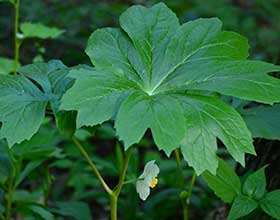 Nothing says May like mayapples! Mayapples (technically, Podophyllum peltatum) have no relation to apples, and they first poke up through the leaf litter around the end of March. It takes a few weeks, though, for the large, umbrella-like leaves to unfurl and grow, and for buds to set and mature. So, it’s the mayapple flowers that ring in the month of May.
Nothing says May like mayapples! Mayapples (technically, Podophyllum peltatum) have no relation to apples, and they first poke up through the leaf litter around the end of March. It takes a few weeks, though, for the large, umbrella-like leaves to unfurl and grow, and for buds to set and mature. So, it’s the mayapple flowers that ring in the month of May.
Mayapples usually appear in clusters, or colonies, containing up to hundreds of plants. But really, those plants in a colony are all part of the same individual; they all connect to a common underground stem, or rhizome, and they are genetically identical. That doesn’t mean that all of the emerging shoots look the same, though. In fact, mayapple plants grow in two forms. Most emerge as a single leaf on a stalk and are vegetative. They do not produce flowers or fruit, but their photosynthesis generates nutrients that are stored in the rhizome to support the next year’s growth. A minority of shoots, sometimes fewer than 5%, instead have a stalk that splits to support two leaves. On those shoots, a flower emerges at the junction of the split.
Mayapple flowers are quite beautiful. They are about 4 cm (1.5 inches) in diameter, with pure white petals and stamens that bear bright yellow anthers. Despite that showy form, mayapple flowers are easy to miss, as they hang under the converging umbrellas of the colony’s leaves. The flowers open right about at the start of May, then begin to fade after a week or so of blooming.
Mayapple flowers cannot fertilize themselves (they are “self–incompatible”). So, they need assistance in transferring pollen from one flower to another (or, really, from one colony to another). The mayapples’ main pollinators are bumblebee queens; bumblebee workers typically don’t appear in Ohio until about mid-May, too late to pollinate mayapples. Oddly, though, mayapple flowers do not produce nectar as a lure for the bees. Instead, they rely on bees that are in the neighborhood visiting other flowers and that happen to stop by the mayapple blossoms almost by accident. Mayapples thus rely on flowering in the vicinity of nectar-rich “magnet” species that encourage visits from bees; a deficiency of pollinators sometimes limits mayapple fruit production.
The green, oblong fruit of the mayapple is about 1 cm long and hangs on the plant through July. The fruit is consumed by a number of animals, even before it’s fully ripe. Most seeds die if they are digested by deer, but raccoons and box turtles pass the seeds through and help to disperse them away from the parent population.
Although the ripe mayapple fruit is edible, the unripe fruit and the rest of the plant are quite toxic. The main active chemical is eponymously called podophyllotoxin, PPT. PPT inhibits cellular division (mitosis), and it has been evaluated for human medicinal uses related to that action. PPT, or derivatives of it, has proven effective for several forms of cancer. It also is used in topical application against viruses like herpes. PPT is listed by the World Health Organization as an essential medication.
It turns out that PPT is quite a complex chemical, and it has proven difficult to synthesize in the laboratory. So, most podophyllotoxin has continued to be procured by extracting mayapple rhizomes or leaves. The industry has mostly done this using an Asian relative of our local species, but overharvesting has substantially reduced its availability. There now are efforts both to cultivate North American mayapples commercially and to develop new methods for synthesizing PPT, perhaps by genetically programming bacteria.
Although the plants are full of toxic podophyllotoxin, that does not inhibit the mayapple rust fungus, Allodus podophylli, from colonizing the leaves. As the growing season progresses, it becomes more and more common to see mayapple leaves patterned with light-colored spots on their upper surfaces. Turn those leaves over and you’ll see the tiny orange spore cups produced by the fungus. The plant seems to tolerate the fungus well, and the spotty leaves are quite attractive.
With or without the fungus, mayapple leaves begin to wither by July and fall away by August. The rhizomes persist underground, mostly replenished by the year’s vegetative growth, but somewhat depleted at the nodes that bore flowering stems. The old joke says that April showers bring May flowers, and Mayflowers bring … Pilgrims. Mayapples, on the other hand, bring beautiful flowers, food for box turtles, therapeutic medicine, and the promise of a repeat show the next year. That’s pretty nice!
Article and photo contributed by Dr. David L. Goldstein, Emeritus Professor, Department of Biological Sciences, Wright State University.
